On the night between Thursday
2nd and Friday 3rd March, 1944, in a railway tunnel
on the Battipaglia-Potenza line, in Italy, located between Balvano-Ricigliano
and Bella-Muro Lucano stations, in the region Basilicata, hundreds
of 8017 train passengers died, suffocated by the smoke of the
locomotives, in one of the most serious railway accidents in history,
the most serious to occur in Italy. The US Army 727th
Rail Operations Battalion Activity Report,
published in 1948, comments on the accident: "Probably
never in the history of railroading has there been a catastrophe
such as occurred at Balvano".
The strong discrepancies in the number of victims between the
different sources and the difficulties in burying hundreds of
bodies in a very limited time and space make it credible that
the number of victims was higher, even much higher, than the body
count or the number of missing people. from train 8017, reported
by his relatives. The number of six hundred victims appears anything
but improbable and part of the very numerous missing persons of
the period could have been among the casualties of the Balvano
disaster, if not killed in war, under bombings, from illnesses
or in accidents or attacks, which commonly occurred in that age.
The preconditions
for the tragedy
In March 1944 southern
Italy had been liberated, the Nazi-fascists had fled to the north,
the front was stopped on the Garigliano river and the battle of
Cassino was underway, with the destruction of the Montecassino
abbey on 15 February. Naples was liberated with the Four Days
Revolt (27-30 September, 1943), while Potenza was liberated on
22nd September, 1943 (Barneschi, 2014). However, the devastation of
the war and the limitations on trade imposed by the Allied Forces
left the city's population in a state of extreme poverty, and
the lack of food literally led many people to starvation. The
only resource for the population of Naples and the coastal area
was to look for food where it was still found, in the countryside,
bartering it with the few objects left at home. So many set out
on foot towards the hinterland, or they relied on the very few
carts or motor vehicles, or even on train 8021, which connected
Naples to Bari, via Potenza and Taranto, with a journey that could
even last 24 hours, in program only twice a week, on Wednesdays
and Saturdays (Barneschi,
2005), and which was
consequently overloaded.
Twenty days before the tragedy, on 13 February, 1944, Giovanni
Di Raimondo, Undersecretary of State for Communications for Railways,
Civil Motor Vehicles and Transport under concession of the Badoglio
government, who later became Director General of the State Railways,
in a letter to the State Railways Department heads of Naples,
Bari and Reggio Calabria and, for information, to the Cabinet
of the Presidency of the Council of Ministers and to various ministries,
referred to the bi-weekly Bari-Naples train via Potenza, explaining
that "it has proven to be absolutely insufficient with
respect to the needs of the large population of the regions crossed.
The train itself is assaulted by an overwhelming crowd of travelers
who wait for a long time in the various stations, especially between
Metaponto and Battipaglia". Consequently Di Raimondo
asked for a daily train, or at least three times a week. In reality
the allied authorities, in the person of Colonel Charles F. Dougherty,
had already made it clear on January 26 that due to military needs
it was not possible to increase the frequency of the train
(Restaino). The only remedy from the Allied
authorities was instead a blunt, often violent, repression of
the access of passengers on freight trains, and an unloading of
responsibility on the Italian authorities, with the request for
a mass of controls that were impossible to carry out.
As a matter of fact, for safety reasons, the Allied authorities
had set a maximum number of tickets for each train, moreover requiring
the possession of an authorization to travel. Anyway, the mass
of people trying to move, driven by hunger, was pressing. Many
travelers were therefore unable to find a place on passenger trains,
and the alternative was to board, as illegal passengers, however
tolerated, and often equipped with a ticket, on the freight trains
that travelled along the line to Potenza. Train 8017, the one
involved in the tragedy, operated on the same route on a non-regular
basis, as an "OL" ("Orario Libero") train,
i.e. at free schedule, and was used for the transport of weapons,
ammunition and materials for use by the Allies, and was therefore
under their control, although it was operated by Italian railway
crew and rolling stock. All this even if a part of the Allied
territory, including the area of the accident, should have returned
under Italian sovereignty on the basis of a decree of February
1944 (Martucci).
Journeys on these trains, as well as being difficult, were also
dangerous for the safety of the passengers,
who often traveled clinging to the outside, as reported in La Domenica del Corriere
of 3 October, 1943, or with legs astride on the buffers, on coal
tenders or on the imperial (roof) of the carriages, risking being
crushed between the train and the tunnels vault if they didn't
quickly lie down. Furthermore, it happened that entire carriages
were emptied to make room for the Allied soldiers (Barneschi, 2005).
Balvano
The town of Balvano
is located in the province of Potenza, in Basilicata region, in
Italy. On 1st January, 2023, 1,726 people lived
there, while in 1936 the inhabitants were 2,481 (Istat.it). Balvano lies at the border with the province
of Salerno, in Campania, at 425 m (1,394 ft) above sea level.
The town was seriously damaged by the earthquake of November 23,
1980, which made 77 victims, and was completely rebuilt in the
following years. Starting from 1987 a confectionery industrial
plant of Ferrero operates in Balvano territory.
The railway
line
The Naples-Bari
line is essential in the transport of travelers and goods between
the Tyrrhenian and Adriatic coasts. It is divided into several
stretches with junctions in Salerno, Battipaglia, Potenza,
Metaponto and Taranto. The Battipaglia-Potenza-Metaponto stretch
was built between 1863 and 1880, it was under the responsibility
of the State Railways from 1905 to 2001, and is still single track.
The Balvano accident occurred in the Battipaglia-Potenza
stretch, which, after the initial course on plains or low hills,
climbs up the Apennines, and in particular in the segment between
Balvano and Baragiano it runs almost continuously uphill, along
the meanders that the Platano stream
digs into the mountains. The torrential regime of the Platano
causes sudden floods, one of which in 1929 swept
away twelve railway workers who were inspecting a tunnel,
killing seven of them.
The sloping profile for a long stretch of the line had caused
another serious accident: on 12 December, 1942, a troop train,
headed for embarkation for North Africa, which had originated
in Piacenza, set off from Potenza, traveling in the direction
of Naples, therefore going downhill. After the Tito station, at
792 m (2,598.43 ft) above sea level, perhaps due to a brake failure,
the train picked up speed and, after the Franciosa stop, at 522
m (1,712,6 ft) above sea level, after a run of almost 12 km (7.4
Mi), it broke into two parts, one of which went off the railway
track and crashed, causing 29 deaths and 150 injured (Barneschi, 2005).
Since 1959 the line has been served by diesel locomotives (Restaino), and only on 31 March, 1994,
just over 50 years after the disaster, it was electrified, after
eight years of closure for the necessary works (Barneschi, 2005).
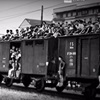
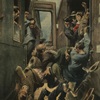
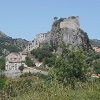
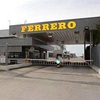
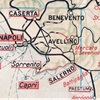
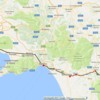
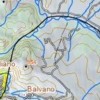
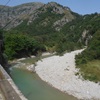
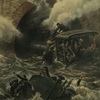
Balvano
railway station
The last stop of train
8017 was Balvano-Ricigliano railway
station, which was also the place where the few survivors
able to walk headed, the reference point for the rescue operations
and the first shelter for the bodies recovered from the train.
The station, together with the
Romagnano-Balvano section of the line, was inaugurated on 3 June,
1877, and is located at km. 124,842 (77.57 Mi) from Naples, at
an altitude of 264 m (866 ft) above sea level, 2.7 km (1.67 Mi)
from the town. It was partially destroyed by the earthquake of
23 November, 1980 and entirely rebuilt.
Today it no longer has the status of a station but is a stop,
where only two trains stop per day for each direction, and is
not served by railway staff on site.
The tunnel
The entrance
of the "galleria delle Armi"
tunnel, is located in the municipality of Balvano, about 5 kilometers
(3.1 Mi) from the town center, near the border with the province
of Salerno (coordinates 40.66467728361175, 15.50313862651606).
The tunnel, 1,968.78 meters
(6,459 ft) long, with a gradient of 13 per mil, is the longest
of the 37 on the Battipaglia-Potenza section (www.antiarte.it), is located 1,791 meters (1.11
Mi) after the Balvano station, at km 126.633 (Mi 78.69), and takes
its name from the mountain under which it passes, Monte dell'Armi,
957 meters (3,140 ft) high. In turn, the mountain would take its
name from the arms hiding places created by the brigands who operated
in the area until the end of the 19th century, or from the medieval
Greek word armos, meaning "cliff" (www.antiarte.it). Restaino refers he heard it
called "de lu battaglione" ("of the battalion",
giving it a military meaning.
The tunnel is straight, apart from the final stretch which bends
to the right (coming from Balvano), runs in an "s",
and in the last segment is flanked by 37 large
windows (see plan, from
Restaino). Before the change of direction there is a service tunnel
that comes out into the open and serves as a ventilation duct,
although it is largely blocked by landslides. Neither the duct
nor the windows served to save the passengers of train 8017 from
suffocation, because the train stopped much earlier.
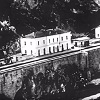
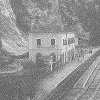
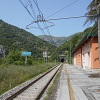
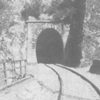
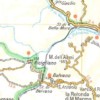
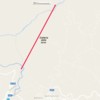
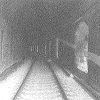
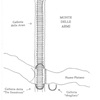
The class
476 locomotive
The 476 locomotives
were built between 1909 and 1918 in three different Austrian factories,
and were used by the Imperial-Royal Railways of the Austrian State
(KkStB, Kaiserlich-königliche österreichische Staatsbahnen)
with the code KkStB 80. At the of the First World War, 72 of these
locomotives passed to the Italian State Railways, because they
remained on the territory that had become Italian, or because
they were handed over by the Austro-Hungarians as war booty. In
turn, at the of the Second World War, some locomotives of the
476 group, which were located in the ex-Italian areas that passed
to Yugoslavia, were acquired by the Yugoslav railways with the
code JDŽ 28. The conduction,
i.e. the position of the driver, was on the right of the locomotive
(Barneschi,
2005). On train 8017
the specimen on duty was, according to Barneschi 476.023, based
on Wikipedia
476.058, Restaino and Raimo report 476.038, according to Canzoni
contro la guerra. A specimen, 476.073,
is located at the Railway
Museum of Trieste Campo Marzio (currently, March 2024,
the museum is closed).
The class
480 locomotive
The 480 locomotives
were built in 1923 in 18 specimens by the Officine Meccaniche
of Milan. The conduction was on the
left of the locomotive (Barneschi, 2005). They had five coupled axles, a maximum
speed of 60 km/h (37 mph) and were designed to work on the Brenner
railway, which became Italian after the First World War. With
the electrification of the Brenner line in 1930, some locomotives
were transferred to the depots of Catania and Messina and six
engines were sent to the Salerno depot, including 480.016,
in service on train 8017, which in 1966 was still in service at
the Catania locomotive depot. Another specimen, 480.017,
can be seen at the National
Railway Museum of Pietrarsa, near Naples.
The crew
On the 480.016 the
engineer was Espedito Senatore and the stoker Luigi Ronga, who
was the only one of the crew of the two locomotives to survive,
as he fainted and fell on the roadbed, finding a little more oxygen
at ground level, enough to make him survive (Pocaterra). The engineer Matteo Gigliano, 55, from
Salerno, and the stoker Rosario Barbaro, 31, from Torchiara (province
of Salerno) (Martucci) served on the 476.023. The train
manager was Luigi Ventre from Cava de' Tirreni (Salerno), the
head controller was Domenico Sessa, 43, from Pellezzano (province
of Salerno), the controller was Vincenzo Cuoco, 45 years old from
Benevento and the brakemen were Roberto Masullo and Giuseppe De
Venuto. There were also, as workers acting as brakemen Michelangelo
(or Michele) Palo, Giuseppe Scarcella and Gaetano Sgroia aged
34. Also on board, but not on duty, were brakemen Onofrio D'Ambrosio,
21, from Ricigliano (province of Potenza) and Paolo delli Carri,
49, from Benevento. Only Ronga, Masullo, Scarcella, De Venuto
and Palo survived (Barneschi,
2005).
The journey
Freight train 8017
left Naples in the early afternoon of March 2, 1944, headed to
Catanzaro, via Potenza, the only possible line, given that the
Tyrrhenian line was impassable due to Allied bombing (Barneschi, 2014). The train was bound to load
wood intended for the restoration of bridges destroyed by the
war, and was initially made up of 23 empty wagons and one service
wagon (Barneschi,
2005). Even though
the train was almost completely empty, six carriages were not
sealed and were occupied by unexpected passengers.
The train was hauled by an E626 electric
locomotive (Raimo), but, given that the line from
Battipaglia to Potenza was not electrified, a steam locomotive,
type 476, came
into operation in Salerno. The train left Salerno at 5:15pm (see
the graphic representation of the
journey), and along the way it became loaded with passengers.
After 74 km (46 Mi) from Naples, shortly after 6:00pm it reached
the Battipaglia station, where, before the beginning of the sloping
railway, locomotive 480,016 was joined in front of the train,
but 24 more freight wagons were also added, bringing the total
number to 48. Again in Battipaglia, the Allied military police
violently cleared the train of stowaways, but many of them immediately
got back on, and the train set off again overloaded. In Persano
two wagons were discarded and in Sicignano one more was excluded,
so at 0:12am the convoy arrived in Balvano, with 45 wagons, and
set off again at 0:50, passing through the first short
tunnel immediately after the station, then a bridge
over the Platano, then two other tunnels, while the railway line
gradually increased its gradient, and at the fourth tunnel, the
delle Armi, the speed was extremely
reduced, until, after 500 meters (1,600 ft) from the entrance
to the tunnel, the train stopped.
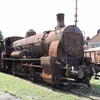
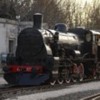
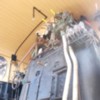
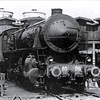
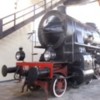
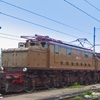
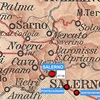
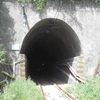
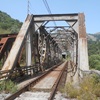
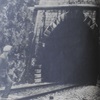
The tragedy
Train 8017 found the
tunnel already saturated with smoke, left by the locomotive of
the previous train, 8013, which had passed about an hour earlier.
Stopping about 500 meters (1,600 ft) from the entrance of the
tunnel, probably due to various contributing factors, which added
up by fate, it only managed to retreat about 200 meters (650 ft),
allowing the people who were in the rear carriages to exit the
tunnel and save themselves. The other people, who remained in
the tunnel, almost all died suffocated by carbon monoxide, produced
by the incomplete combustion of bad quality coal, perhaps worsened
by the introduction of coal from the tender
before entering the tunnel, a practice prohibited as it is dangerous,
due to the strong release of toxic gases from the coal just put
in the boiler. Many of the passengers were stunned, almost without
realizing it, others were asleep, and passed imperceptibly from
sleep to death, without having the possibility to react or be
afraid, as evidenced by the relaxed position in which their bodies
were found by the rescuers.
News of
the accident arrives
The station manager
of Balvano, Vincenzo Maglio, who had given the departure signal
to the train, should have received from the station manager of
the next station, that of Bella-Muro, at km. 132.600 (82.40 Mi)
(7.758 km, 4.82 Mi after Balvano) the telegraphic notice that
the train had arrived. Not having received the telegram, he was
not initially worried, thinking of a delay due to the many factors
that delayed the progress of the trains, and sometimes required
a travel time of two hours (Caggiano),
and went to sleep, taken over by the deputy stationmanager Giuseppe
Salonia. The latter received from Ugo Gentile, deputy stationmanager
of Baragiano-Ruoti, a request for news on train 8017, which had
not arrived, and at 2:40-2:50am he was reached by a call from
the stationmanager of Bella-Muro. So, he took action to someone
to reconnoiter the line. At around 3:00am the telegrapher of the
Potenza station, Luigi Quaratino, received a message from the
Baragiano station reporting that train 8017 was "stopped
on the line between Balvano and Bella Muro due to insufficient
traction force, awaiting help".
A rescue locomotive left Potenza shortly after 5:00am, and at
5:10am one of the brakemen of the 8017 train, perhaps De Venuto
(according to some sources Palo), who was in one of the rear carriages,
those who when the train he stopped, remained outside the tunnel,
returned on foot to Balvano to raise the alarm. With him, about
a hundred passengers from the rear carriages of the train had
been saved (Barneschi,
2005).
At 5.30am from Balvano station, the locomotive of train 8025,
the one following 8017, left to rescue, and arrived at the galleria
delle Armi tunnel at 5.40am. The rescuers began to notice the
large number of corpses and, among other things, they noticed
that the locomotives were both still under pressure. The people
still in the tunnel who showed signs of life were rescued, then
train 8017 was towed back and, according to the testimonies collected
by Barneschi (2005), the bodies found along the tracks
were mangled by the wheels of the train itself. Train 8017 arrived
at Balvano station at around 8.15am, and from the train
parked at the station the recovered
bodies were lined up on the platform
of Balvano station, and then loaded onto trucks
requisitioned for the occasion.
Balvano's medical officer, Orazio
Pacella, intervened to reanimate the survivors, giving them
injections of adrenaline into their hearts, trying not to make
mistakes, and to choose only people who were still alive, given
that he only had one hundred vials of the drug. After saving 51
lives, he was removed from rescuing the survivors by the allied
doctors, who had arrived in the meantime, and he was prevented
from saving other people (Mussa).
The Carabinieri police of Potenza and the Fire Brigade of Salerno
and Naples also intervened, with the speed allowed by the state
of the roads and the lack of supplies.
The corpses were taken to the Balvano
cemetery, but due to lack of space they were temporarily buried
in four mass graves near the cemetery, for over four hundred bodies.
The land was offered free of charge by Francesco Di Carlo from
Balvano, who died of a heart attack the day after his act of generosity
(Barneschi,
2005). Many of the
victims did not have documents, which perhaps had been lost in
the frantic rescue operations for so many people. In the Balvano
cemetery, Salvatore Avventurato,
a petrol station owner from Torre del Greco, near Naples, had
a marble chapel built at his own expense in memory of the victims,
including his father, his brother and an uncle (Mussa).
Many of the bodies lined up at the station and in Balvano cemetery
were recovered by relatives, who had rushed over in the meantime,
and buried in the cemeteries of their places of origin. This is
one of the reasons for the discrepancy in the death toll between
various sources.
Railway traffic, at the pressing request of the Allied authorities,
resumed the day after the tragedy, on March 4 at 12:00pm. On 9
March, 1944 the Badoglio Government, based in Salerno, dedicated
the entire session to the disaster.
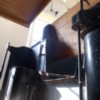
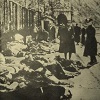
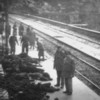
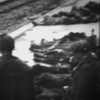
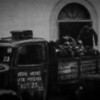

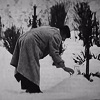

The victims
In the days immediately
following the tragedy, the newspapers reported tolls that varied
from 426 casualties in Il Messaggero, to 500 in Il Corriere
della Sera, to over 500 victims in La Stampa, 509 (the
next day 502) in La Gazzetta del Mezzogiorno. In the following
years, Nino Lo Bello in the Chicago Tribune Magazine, in
addition to Caggiano, Frisoli and Raimo reported 521 deaths, Martucci
reported 427 deaths, with the doubt that they were 521, Pocaterra
and Pepe over 500, the tombstone in the Balvano cemetery 509,
Barneschi (2005
and 2014) over 600.
The discrepancy is due to the large number of bodies to be buried,
combined with the lack of space available and the free initiative
of the relatives of some victims, who independently provided for
the burial of their loved ones.
The only "illustrious" victim was Professor Vincenzo
Iura, 65 years old, from Baragiano, professor of surgical pathology
at the University of Bari and surgeon at the Civil Hospital of
Potenza (Pepe). From the list of 434 names cited
by Restaino it is clear that the victims were almost all from
Campania (87.3%), from the provinces of Naples (54.8%) and Salerno
(31.3%), with a particular concentration in the Vesuvian area,
with 81 of the victims coming from Resìna (today Ercolano)
and many others from Torre del Greco (27), Castellammare di Stabia
(25), Portici (17), Boscoreale (14), Boscotrecase (13), Torre
Annunziata (10), and, for the province of Salerno, many came from
Cava de' Tirreni (28), Nocera Inferiore (24) and from the Amalfi
Coast.
The causes
The Balvano accident
probably had various contributing causes, which were invoked by
the various parties involved and by the press, often according
to personal and institutional convenience and the needs of war
propaganda, given that the war was still ongoing and would have
ended, in Europe, just over a year later.
Many have succumbed to the temptation to present the tragedy as
the result of a dark conspiracy or, at the very least, as the
outcome of specific faults and responsibilities, of individuals
or institutions, then covered by silence and a willful oblivion.
We have seen how for other tragedies that occurred in the following
decades, the memory was kept alive only by a few, and in particular
by the relatives of the victims, and in case the oblivion was
aided by those who wanted to cover up deliberate acts, such as
terrorist attacks, while accidental tragedies, such as that of
Balvano, have often been forgotten because they were considered
fortuitous events, for which no one could be considered responsible,
or because the possible culprits were among the victims. Thesearch
for causes was certainly made less easy by the chaotic situation
of the time, with southern Italy set free but devastated by the
war and subjected to a harsh Allied government, often with punitive
connotations for the past belligerence with the Germans, in addition
to the presence of the front about two hundred kilometers away.
Here is a brief review
of the possible contributing causes of the Balvano tragedy:
Coal The poor quality of the coal used
by the two locomotives, of Yugoslavian origin, supplied by the
Allies, could have caused at the same time a lower thrust of the
engines, due to the reduced calorific value of the fuel, and poor
combustion, with the production of smoke with a higher carbon
monoxide content, in the first case contributing to the train
stopping, and in the second case saturating the tunnel with toxic
smoke. On the other hand, in March 1944 no other type of coal
might have been available: no longer the German coal from the
former allies, but not yet the Welsh coal from the new allies,
who reserved it for their own uses for the still ongoing war.
Lack
of air exchange The
tunnel runs straight for almost all its way, but in the final
stretch it bents almost at a right angle, due to the addition
of a section of artificial tunnel, made to protect the railway
from landslides. This shape, however, did not facilitate air exchange,
interrupting the flow between the two ends of the tunnel. The
poor breathability of the air was worsened by the stagnation of
smoke from the locomotives of previous trains, in the specific
case of 3 March, 1944 it was train 8013. For the railway workers
accustomed to working on the Battipaglia-Potenza line, the stagnation
of smoke in the galleria delle Armi tunnel was a well-known fact.
Precisely on the same line, in a tunnel between Picerno and Tito,
less than a month earlier, on 8 February, 1944, the engineer Vincenzo
Abbate, driving a 476 locomotive, had found himself in conditions
of asphyxiation and, to breathe better, he had raised the flippable
gangway between the locomotive and the tender, lying down on his
face, to better breathe the air of the layers closer to the rails.
However, he had fainted and his head had remained crushed between
the locomotive and the tender, and he had been killed (Barneschi, 2005).
Overloading Due to the poor quality of the
coal, the allied authorities, in particular the Military Railway
Service of Salerno, had given instructions not to load the trains
beyond 350 tons, which could be increased to 630 in the case of
double traction, even if there is no written trace of such provision.
The actual load of train 8017, after the Battipaglia station,
is unclear, and varies, deping on the sources, up to 520 tons,
with a length of 479.30 meters (157,250 ft) (Barneschi, 2005). In any case, the official load
of freight did not take into account the over six hundred passengers
who boarded clandestinely, whose weight can be estimated at over
40 tons. The shortage of trains in liberated Italy created a demand
for transport much greater than supply, and train 8017 was probably
overloaded, due to the excessive number of carriages and the weight
of hundreds of passengers.
Skidding The lack of thrust on the long
climb from Balvano to Bella was worsened by the strong humidity
of the tracks in the tunnel, due to the condensation of smoke
from the locomotives, to the low temperature of early March, and
to the dripping from the vault and walls of the tunnel, coming
from the circulation of water inside the mountain. The skidding
should have been contained by the release of sand on the tracks,
which perhaps did not happen or was not sufficient. Pocaterra
reports the story of a train driver from Bologna who in 1954 described
the frequent skidding of the 476 locomotives uphill in the tunnels
of the Calabrian lines, with the further difficulty of the hardness
of the throttle lever, which required two people to operate it.
Misunderstanding
among the railway crew
According to some,
the train's sliding backwards would have pushed the engineer of
the first locomotive to backtrack to exit the tunnel, but the
brakemen at the rear would have misunderstood, believing that
the sliding backwards was accidental, and would have tightened
their brakes, creating a stall, while the engines went at maximum
power, increasing the production of smoke. According to one of
the rescuers, the operator Mario Motta, no less than thirteen
cars had been braked (Restaino). The length of the train made
communication between the head and the rear impossible.
According to Raimo, the reversing lever of engine 480.016 was
in the forward gear position, while in the rear engine the lever
was placed in reverse position, which would have created a stall
due to the conflicting thrusts. However, the fact that the two
locomotives were driven from opposite sides made communication
between the two engineers difficult. According to Restaino, however,
still referring to the testimony of the operator Mario Motta,
both cars were set to reverse gear. According to Barneschi (2005), based on the inspection carried
out on the two locomotives when they were brought back to Balvano
station, the 480 was in reverse gear and the 476 was in forward
gear. It is not unlikely that, after the accident, the controls
were tampered with, or that untrue news was reported, to clear
oneself of possible involvement in the disaster.
Loss
of consciousness of the engineers Both
engineers died in the Balvano tragedy, so at a certain point in
the accident they will have lost consciousness, no longer being
able to intervene in any way on their respective engines. Furthermore,
the difficulties in operating the throttle lever, reported by
Pocaterra, would have been even greater for a driver on the verge
of suffocation.
The
allocation of passengers According
to the Allied commission of inquiry, the majority of passengers
"in consideration of the best protection from the weather"
were found in the front carriages of the train, those trapped
under the tunnel, while passengers placed in the rear carriages,
which remained outside the tunnel, and who were saved, were many
fewer (Barneschi,
2005).
The account
of the Americans
The above mentioned
report
on the activity of the 727th US Railway Operations Battalion
recounts the work of the military unit during war operations in
North Africa, Italy and France. The tragedy of Balvano is told
as something that had never happened in the past on a railway
line, which happened on 5th March, 1944 (in reality it was
two days before), due to illegal invaders ("trespassers")
who went to Bari, Brindisi and Taranto (the train actually ended
in Potenza), to get food, olive oil and other things from the
black market in Salerno, Naples and numerous other Italian cities.
There is therefore a strong negative prejudice against Italians,
seen as habitual violators of the law, without taking into account
the poverty and hunger caused by the war and, among other things,
by the Allied bombings. Furthermore, we seem to read a sort of
racist moralism, according to which the Italians, criminals or
at least undisciplined, had paid for their transgressions with
their lives.
The dynamics of the accident are traced back to the poor quality
of the coal, the locomotives slipping and overloading. The number
of victims is estimated at 508, and the report is careful to specify
that no American military personnel were involved. American investigators
would have interrogated many Italians involved in the incident,
especially railway workers working in the area. The investigation
gave no results and General Gray defined the tragedy as a fatality
("an Act of God"). In the meantime, a similar
accident had occurred near Baragiano, ten kilometers from Balvano,
with only one victim.
The Chicago Chronicle of 20 March, 1951, in reporting the
news of the summons from the Italian State by the victims' relatives,
gives different information: the newspaper wrote of 427 deaths,
of a journey south to load weapons and ammunition, and blamed
Yugoslavian coal, which quality was very poor.
The account
of the fascists
The first news of
the tragedy reached Italy occupied by the Nazi-fascists through
dispatches from Lisbon issued by the British Reuters agency. The
Milan newspaper Il Corriere
della Sera, published in the republican puppet state of
Salò, on 6 March in a short article summarily recounting
the incident, without specifying the location, reporting a death
toll of 500. On the same front page it reported 600 casualties
in the Allied bombings.
On March 7, the Turin newspaper La
Stampa reported the disaster, and the following
day published further details, and citing «serious
responsibilities of the "liberators"» reported
that on the train "militaries and civilians had been made
to travel" (sic) including numerous women and
children, and among the wounded there would have been English
soldiers. The newspaper of Rome Il
Giornale d'Italia of 7 March reported 501 deaths, locating
them generically in southern Italy, on a train heading east, while
Il Messaggero of
23 March, the same day of the attack in Via Rasella and of the
start of the retaliation of the Fosse Ardeatine (see my webpage
on it), published the news, referring of a toll of 426 "Italians",
also hypothesizing victims among the allied soldiers, maliciously
kept quiet. Il Messaggero was also and still is a newspaper
from Rome, at the time under Nazi occupation, even though it formally
had the status of an open city.
Similar
massacres
Accidents caused by
passengers and train staff suffocating due to smoke in tunnels
were not uncommon, although they often ended without casualties.
In the past, several accidents had occurred in Liguria, at the
end of the 19th century. In one of these accidents, on 11 August,
1898 at approximately 8.00pm, freight train 3132 left Genoa and
headed for Ronco Scrivia, crossing the Giovi tunnel, in the municipality
of Serra Riccò, in the province of Genoa. In the tunnel
the train remained uncontrolled due to the asphyxiation of the
crew, and rushed on passenger train 120 stopped at the Piano Orizzontale
dei Giovi station. The accident caused nine deaths, including
two children, and over one hundred injured, and triggered a series
of discussions, among other things on the quality of the fuel,
briquettes made of coal dust mixed with pitch and tar, produced
by the Carbonifera company of Novi Ligure, owned by the member
of parliament Edilio Raggio, who tried to oppose the replacement
of the briquettes with real coal from England. The legal proceedings,
however, were unsuccessful.
Memory
Two plaques have been
placed at the Balvano station in memory of the tragedy, one dated
3 March, 2017 and another
which refers to the event "San Mango-Balvano: percorso
di memoria e di futuro" ("San Mango-Balvano:
path of memory and future" jointly promoted by the Pro
Loco of Balvano and San Mango Piemonte (province of Salerno) to
remember the tragedy of train 8017.
The American country singer and songwriter Terry
Allen dedicated the song “Galleria dele Armi”
(sic) to the tragedy (listen on YouTube),
in his 1996 album "Human
Remains".
On March 3, 2004, on the 60th anniversary of the Balvano tragedy,
the Cyberassociation "Treno
di Luce 8017" ("Train of Light 8017"
was founded, with the task of bringing together the families and
friends of the victims of train 8017. The creators of the association
explain that "Il Treno di Luce is not only a material
convoy but a celestial means to remember all those dead, victims
of a useless holocaust, the result of war and of the so-called
civil life that overwhelms the poor. For this reason the Treno
di Luce wants to travel on the rails of Cyberspace to bring his
message of peace against the war and the oppression of the weak
by the strong.”
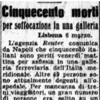
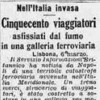
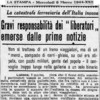
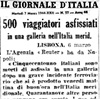
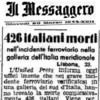
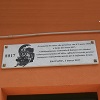
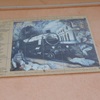


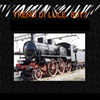
Legal
aftermaths
On 11 November, 1945
the investigating judge of the Potenza Court decreed the dismissal
of the case, at the request of the Prosecutor of the King's Office
of Potenza, as the fact did not derive from fault or fraud, being
due to the poor quality of the coal (Barneschi, 2005). In 1946 the Court of Potenza
initiated proceedings to identify possible criminal liability,
but on 18 December of the same year the proceedings were closed
and no culprits were identified. In the same 1946 Luisa Cozzolino,
Michele Palumbo's widow, who had lost her husband in the massacre,
brought proceedings to ask for damage compensation from the State
Railways. This request was followed by 300 more requests from
the families of the victims, and then the proceedings were reduced
to 41, because many families joined in, relying on the same lawyers.
The total compensation exceeded one billion liras. The defense
of the State Railways requested the dismissal because the railway
traffic at the time was under the responsibility of the Allies,
and it was "damage caused by the Allies as a consequence
of non-combat actions". Furthermore, the victims did
not have tickets, and therefore there was no contract between
the company and the passenger for transport. Finally, jurisdiction
over the matter fell to the court of Potenza, and not that of
Naples. The railway company appealed to the Court of Appeal of
Naples (Martucci). The trial began on March 28,
1951, and was the occasion for a resumption of media attention
on the massacre. The dispute ended with the payment of compensation
for civilian victims of war events, limited to those who could
show a ticket (Wikipedia).
Investigative
reports on the massacre
In the years following
the massacre, the weekly Oggi of 15 March, 1951, with an
article by Corrado Martucci, dealt with the resumption of civil
action proceedings for damages by the victims' relatives, recalling
the events of seven years earlier. In 1956, on 11, 18 and 25 March,
the weekly L'Europeo published an investigation in three
episodes by Giulio Frisoli, with a strong sensationalist slant
and with plenty of faults. On 25 May 1957 the Rome newspaper Il
Tempo published an article by Nestore Caggiano which recalled
the massacre, upon the resumption of proceedings for compensation
for damages before the Court of Appeal of Naples.
More than twenty years of silence followed, until Cenzino Mussa's
article in Famiglia Cristiana of 4 March 1979, which recalled
the facts. The following year, in issue 4 of the railway journal
Strade ferrate of November 1980, Nicola Raimo published
an article full of technical details and testimonies from the
survivor of the tragedy Luigi Ronga. In 1995 Renzo Pocaterra,
in the railway monthly Linea Treno, told the story of the
event, presenting Restaino's book (see next paragraph).
The first book on the Balvano massacre was "Un
treno un'epoca: storia del 8017" ("A train,
an era: history of 8017" published in 1994 by Mario Restaino
for Arti grafiche Vultur of Melfi (province of Potenza). The Rome
lawyer Gianluca Barneschi wrote two books on the massacre, "Balvano 1944. I segreti di un disastro
ferroviario ignorato" ("Balvano 1944. The
secrets of an ignored railway disaster") published in
2005 by Ugo Mursia Editore S.p.A., of Milan and "Balvano
1944. Indagine su un disastro rimosso" ("Balvano
1944. Investigation of a repressed disaster"), published
in 2014 by Libreria Editrice Goriziana of Gorizia. Alessandro
Perissinotto published "Treno
8017" ("Train 8017") for Sellerio
of Palermo in 2003, then republished by Gruppo Editoriale L'Espresso
S.p.A. of Rome, a detective novel that is closely linked to Balvano's
tragedy, the starting point of fictional events that take place
in the following years.

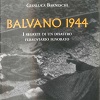
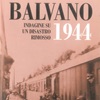

Final
thoughts
In many texts written
about Balvano massacre, the victims are described as black marketeers,
smugglers and trespassers, because they did not have a ticket.
In reality, the desperate situation in southern Italy, which had
just gone through the war, and with the front still a short distance
away, was such as to force many people to look for food in the
places where it was still available, i.e. in the countryside,
trying to barter it with every goods they could find by emptying
their homes: clothing, jewels, watches, and anything else that
might have value for those who had food to give away.
So it was something very different from the black market, which
according to De Mauro's dictionary of the Italian language consists
of the "illegal and clandestine purchase, at increased
prices, of monopoly, rationed and difficult-to-find products".
In the case of many passengers on train 8017, the goods acquired
were not intended to be sold at a higher price, but rather consumed,
so as not to die of hunger.
There may have also been black marketeers on board the death train,
but first of all, how can we distinguish them from the respectable
people described above? And why equate speculators and honest
people looking for food to take home?
The racist pressure came not only from the Anglo-Americans towards
the Italians, but also from other Italians towards their compatriots
from southern Italy. In 1956 Giulio Frisoli wrote: "the
convoy was packed with unauthorized passengers, mostly small black
marketers" (L'Europeo, no 12 (544), p, 55) and "the black marketers
did not give up their work, they rightly trusted on certain qualities
typical of southern Italy" (id., no 11 (543), p, 15). Yet the black market was also
commonly practiced in northern Italy!
As for the violations, it emerges from the testimonies that many
of the passengers on the freight trains were formally illegal,
but often had a ticket, regularly purchased on the ground or on
the train itself, emptied by the traveling staff in a regular
manner, with the issuing of "bills", but also in an
unclear way, even with payment in kind.
The distinction between regular traveler and illegal transgressor,
however, acquired its importance in the case of a request for
compensation from the victims' families: transgressors were not
entitled to anything, while regular travelers were. Death, however,
was the same for all of them.
Bibliography:
ARGENZIANO
Salvatore () Il Treno 8017 Una tragedia dimenticata Balvano, 3
marzo 1944 02 - Il Disastro dell’8017
BARNESCHI Gianluca (2005) Balvano 1944. I segreti di un disastro
ferroviario ignorato. Ugo Mursia Editore S.p.A., Milan, Italy.
BARNESCHI Gianluca (2014)
Balvano
1944. Indagine su un disastro rimosso. Libreria Editrice Goriziana,
Gorizia, Italy.
CAGGIANO Nestore (1957) Morirono 521 viaggiatori nella "galleria
delle Armi". Il Tempo, 25 May 1957, p. 10.
FRISOLI Giulio (1956) La più grande tragedia ferroviaria
di tutti i tempi. L'Europeo, n. 11 (543), p, 12-15; n.
12 (544) p. 52-55, n. 13 (545) p. 37-39.
ISTAT Istituto Nqzionale di Statistica (2022) Bilancio demografico
mensile e popolazione residente per sesso, anno 2022. link
MARTUCCI Corrado (1951) Nel tragico "merci" 8017 giacevano
quattrocento cadaveri. Oggi, n. 11, 15 March 1951,
p. 7-8.
MUSSA Cenzino (1979) E la morte scese sul treno. Famiglia Cristiana,
n. 9, 4 March 1979, 40-46.
PEPE Antonio Maria (2003) Balvano, un triste anniversario. La
Nuova Basilicata, 3 March 2003, p. 3.
PERISSINOTTO Alessandro (2003) Treno 8017. Gruppo Editoriale
L'Espresso S.p.A., Roma, Italy.
POCATERRA Renzo (1995) Balvano, l’inchiesta continua. Linea
Treno, May 1995, p. 30-31.
RAIMO Nicola (1980) Quella lunga notte del ’44. Strade
Ferrate, n. 4 November 1980, p. 33-38.
RESTAINO Mario (1994) Un treno un'epoca: storia del 8017. Arti
grafiche Vultur, Melfi, Potenza, Italy.
S.A. (1948) The 727th Railway Operating
Battalion in World War II. Simmons-Boardman Publishing Corporation,
New York, USA. link
S.A. (1951)
Italy Sued for Death on 427 on War Train. Chicago Tribune,
March 20th, 1951, link
S.A. (2014)
Treno 8017 in galleria, 70 anni fa 520 morti. Ansa.it Speciali,
6 January 2014 link
S G. DF.
- S. A. per www.vesuvioweb.com S. Argenziano. Balvano 1943. 02-Il
Disastro dell’8017 link
SAVINO Antonio
(2003) Un altro muro di gomma. La Nuova Basilicata, 3 March
2003, p. 3.
Websites consulted:
Digital
Library of the Italian Senate of the Republic (Avanti!)
link
Digital collection
of journals of the Biblioteca di Storia Moderna e Contemporanea
di RomaDigital collection of journals of the National Central
Library of Rome (Il Messaggero, Il Corriere della Sera, Il
Giornale d'Italia) link
Digital collection
of journals od the Modern and Contemporary Library of Rome (La
Domenica del Corriere, Oggi) link
YouTube -
Terry Allen - Galleria Dele Armi. link
Brigida GULLO
Balvano,
il Titanic ferroviario. Rai Storia. link
Wikipedia
- Disastro di Balvano https://it.wikipedia.org/wiki/Disastro_di_Balvano
Wikipedia
- Ferrovia Battipaglia-Potenza-Metaponto https://it.wikipedia.org/wiki/Ferrovia_Battipaglia-Potenza-Metaponto
Treno di
luce http://www.antiarte.it/trenodiluce/galleria_delle_armi.htm
http://www.trenidicarta.it/treno8017/
 page
created: March
1st, 2024 and last updated: March 10th, 2024
page
created: March
1st, 2024 and last updated: March 10th, 2024